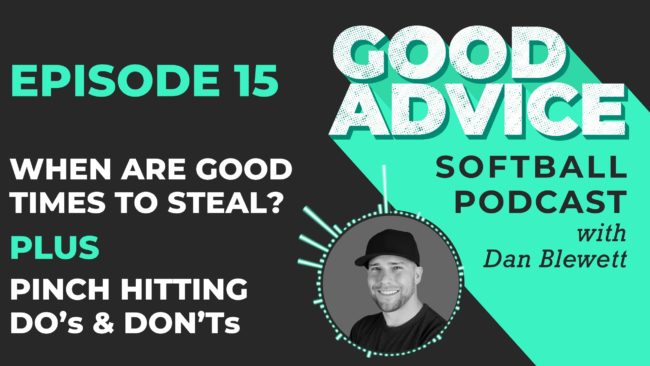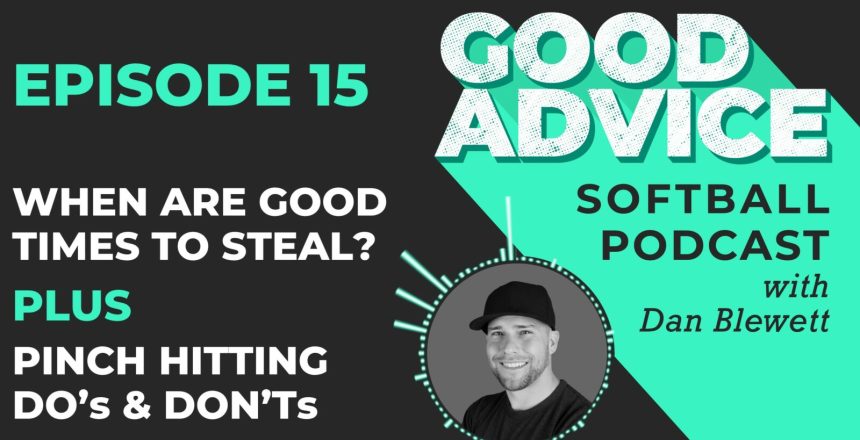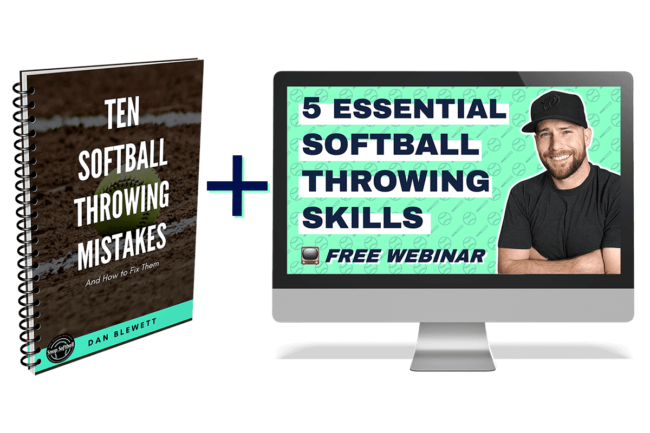*This article may contain product links which pay me a small commission if you make a purchase. Learn more.
When are good and bad times to try and steal bases in softball? Plus, hitting is hard…especially when coming off the bench. Dan gives tips for pinch hitters and coaches to try and make the best of those tight pinch hitting appearances.
To submit a question for the Good Questions Q&A segment, make a voice recording and email it to Dan at hello@danblewett.com. Want to support the show? Enroll in one of Coach Dan’s online throwing courses or his mental skills course. Use code GOODADVICE to save 20% on any course, just for being a listener. Sign up for Dan’s Email list and get his free throwing eBook, and follow up with him on the interwebs: YouTube Channel | Twitter | Snapsoftball.com
Podcast: Play in new window | Download
Subscribe: Apple Podcasts | Spotify
Full Transcript: EP15 – Pinch Hitting Tips and Basestealing Do’s and Don’ts
Welcome back to the good advice softball podcast. I’m Dan Blewett on today’s show. We’re going to cover two main topics first. What are good times to steal? What are not good times to steal? So we’ll talk a bunch about that. And number two. How hard is it to be a pinch hitter? What are some of the considerations and what can coaches do to help make pinch hitting a little bit easier?
Alright. So first off, when does it make sense to steal? So here’s the criteria, essentially. The criteria is. Can I steal a base to put myself into a position where my team can manufacture a run with me being there. So to refresh your memory, manufacturing, Iran is when you move her on her over and then move the runner in through a ground ball to the right side or a bonds, and then a SAC fly, or, you know, another ground ball to the right side, whatever.
But obviously that’s a manufactured run. So it makes the most sense to steal when. Getting into scoring position farther means the now we actually don’t need base hits to score that runner. So there’s two main times when you want to do this number one. With no outs, you want to try to steal second base.
So if you steal second base with no outs, a ground ball, the second baseman will advance that round a third with one out, and now it fly ball to meet him center, field or deeper we’ll score that runner right or left or right field. So that’s one situation where you definitely want to steal second base, if you can, because then again, it doesn’t require a hit to score you ground ball the right side, or a deep sack fly.
And then another sack flier groundwater the right side, and you’ll score that runner. It’s a free run and it’s really difficult for the pitcher obviously to defend that. The other scenario is stealing third with one out. So obviously if you steal third with one out, a SAC fly will score you or ground ball to the shortstop or second baseman.
If they’re conceding the run, we’ll score that runner and let her score from third. So those are the two main scenarios where stealing a base is helpful. Now the other time is, and this is not a manufactured run situation, but stealing second with two outs. Can be advantageous because now you get a chance to basically eat across Iran with a base hit.
So say it’s, there’s no one on and a runner walks with two outs. So now she’s on first with two outs. The ending is still a very low probability of scoring Iran with, you know, you had no one on and two outs and I ever run on first, still three bases away from scoring. But now, if you can steal second with two outs, we just need like one blooper or one ground ball goes through the shortstop’s legs.
And that runner is probably going to score from second cause you’d moving on contact. So those are pretty much the three situations where if you’re going to give the green light to a base runner, who’s got the wheels and you know, the catcher maybe doesn’t have the premium arm. It’s going to make more sense.
Now, if you have a runner on second with no one out, it doesn’t make that much sense to try to steal a third because you don’t need to get to the third with zero outs because you’re already in a position where two SAC flies will score you from second base. So staying put is probably the safest bet. If it’s going to be at all close, if you’re trying to steal third and again, the, the Cardinal sin is don’t make the first or third out third base.
And the reason being. You’re going to score from third with two outs. And are you going to score from second with two outs anyway, so you don’t need to get to third and, uh, you don’t need you to third base with zero outs. For the reason that I just explained, which is that you’re going to score from second with no outs, a high percentage of the time.
Anyway. So it’s just a little bit too greedy trying to get to third was zero or with two outs. Now, again, everyone, you know, people who. Want to argue this with me or with others, is they go, Oh, it’s always easier to score and you’re not just 90 feet away. Well, duh, of course it is. But when you get it to the higher levels of baseball and softball, where.
You don’t just get to stroll into third for free and runners will throw you out consistently. If you’re not a very good base dealer, then it comes down to risk and reward. And there is just not great reward in stealing third base with two outs, because especially, okay. And this is at higher levels of baseball or softball where, you know, the.
Catchers are not trash where it’s not just like, you know, every other pitch in the dirt goes to the dugout and now you score on a pass ball. You know, when it’s, you know, 11, you softball, 12, you softball, 13 new baseball and every fifth pitch goes to the backstop. Sure. Stealing third, you’re probably just going to a walk over to third anyway, on a pass ball.
And then if you’re on third, now you have a choice, choice, or a chance to steal or to score on the next, you know, ball that goes through your. Not very good catchers legs. I get that. And that makes sense. But again, when you get to the point where everyone can catch and throw pretty well, and there’s not as many free bases now you have to be really, you have to really justify stealing third base because you’re going to start to get thrown out, doing it.
And, you know, it’s just the coaches that have, that are very insistent. That being 90 feet is always better. Um, I just don’t think they really weigh the options. And how likely you’re already are to score from second on a single with two outs because you’re moving on contact. It’s relatively certain, unless you hit a scorcher at somebody.
So again, these are the things to consider the best times to steal are with a runner on second. And one out you want to steal a third with one out. Runner on first and no outs or runner and first and two outs cause stealing second with two outs or with no outs, those are both other good situations to steal.
All right. So let’s talk a little bit about pinch hitters and how difficult that role is. So obviously it, for most of you listening. There’s not like a dedicated pinch hitter on your team, right? In higher levels of softball and baseball, a bench player. Who’s not really a starter is going to be, you know, the next in line to basically just like, get that pinch, hit a bat in the, you know, the, the sixth or seventh one, you know, it’s coming down the game’s on the line and maybe they’re just gonna sub in for a hitter.
Who’s just not as, not as strong, but. What they’ve learned on the baseball side from the massive amount of data analytics they now have, is that basically there’s a penalty of about 40 points in batting average that a pinch hitter takes. So if you were a hall of fame, like 300 hitter and you become a pinch hitter, It’s all we can really expect out of you as they hit about two 60, just because pinch hitting is so difficult.
You only, you get less a bat, so you’re less fresh. You sit through almost all the game and then you are called and these stand up and you get a couple of swings and then you jump in there and then you do your best against typically one of the better pitchers at the end of the game. Right? So the that’s, those are the tasks that make pinch and really hard staying mentally locked in during the game.
Quickly going from, you know, sitting on the bench to body, physically warm and ready to go and mentally locked in to go in there and have a good at bat. It’s just not easy. And obviously the more bats you’re getting, the more, um, you know, just the more fresh in the game you stay. So. Again, in baseball, they know there’s a basic, a 40 point penalty.
Even if you’re a hall of fame hitter, you’re going to hit 40 points less. If you’re moved into a pinch, hit her role. So as a coach, that’s important to know number one, because you cannot expect the same results out of a pinch hitter. If you have someone on your bench, who’s more of a role player. And this is, this is still happens in travel ball.
Like, you know, if you have a really premium travel team and you have a player who you’re like, Hey. We’ll take you on the roster, but you’re probably not going to be a starter. Are you okay with that? And they’re like, yep. I just want to be on the team. I want to try to earn my playing time. I know I might not start, but I just want to be there and get better and blah, blah, blah.
You know, that happens. So that might be a player who is the pinch hitter, who she gets one start a weekend and a couple of pinch at a bats. Right? So it’s important for a coach to know that. And it’s important for a coach to also help her as best he can by giving her a heads up. To just look know when she’s gonna get in the game.
Now, this is where forecasting as a coach is important. And really looking ahead down the line, because what you don’t want to do is look down the lineup and point at someone and say, Hey, you’re now up next. That’s not great. They’ve got to throw off their jacket. They got to hop ups or waving their arms around, get their bat, find their batting gloves and they get basically no chance to, uh, to get ready.
Now that happens sometimes. Sometimes it’s just, the game gets weird and that’s the best you can do as a coach. But typically, you know, if it’s like you’re down four to two and the last innings coming up and you look at your batting order and you’re like, okay, if we have a chance to win this game, you know, we’re going to have to send at least five here’s the plate.
So one, two, three, four, five, right? That’s our eight hole hitter. She’s probably my candidates, a pinch hit for. Um, so all right, let’s call Carrie up off the bench. Hey Carrie, look next inning. If we get to the eight hole hitter, you know, a little Sally. You’re going to pinch it for Sally. So be mentally ready that if the game gets that far.
I’m going to call to you right there. And obviously if we don’t get there, then we don’t. But in that situation, she’s like, all right, now she’s got a half inning before her team comes to bat. Again, to start like mentally getting ready, you know, running around, getting loose, going behind the dugout, getting some swings, like you get a chance to dial in.
Now, when this is your role, like for guys who are pinch hitters or girls who are pinch hitters, They start to feel this out. Just like for me as a relief pitcher, I knew when my situation was going to come up because I knew what my role was. And that was again, good communication from my coach. Of course that’s like across the board, just par for the course at a high level baseball and softball.
But I knew that I would pitch if we were ahead. Bye. No more than three runs in the eighth inning. That was my, that was my shot when I was a set up man, my second to last season. So I knew if it’s the sixth inning and it’s two to one and we’re winning. I’m like, all right. If the score holds, I will pitch the eighth, or if we only score one more run, I will pitch the eighth.
So I mentally start getting ready to say, okay, you know, things are going in the right direction for me to pitch, you know, then the seventh comes up and we’re still up two to one. So it’s like, all right, the next thing is mine, unless something changes. So. You’re mentally, just starting to, to cruise towards going into the game, the same as true, the pinch it or pinch hitters.
They have the routine as well, you know, in the fourth or fifth inning, they start to go back into the tunnel, stretch, do their thing. That’s like pregame for them. Cause they know they’re going to pinch it in the seventh, eighth or ninth. You know? So now again, in softball and especially in like youth and travel ball, this is not going to be a much less the case, but again, as a coach, You want to try to map out the game as much as you can and give players a chance to have that role.
So if you have a girl who’s sitting in the bench and as she started the previous game, which she’s not going to start this game, but you do think she might pinch hit. If you get there, this is where you say where the game, Hey, you know, a little Tina. If we get to this kind of situation, the sixth inning, I’m probably gonna pinch it for you.
So make sure you’re watching the game. So if it’s close and one of these two hitters comes up or they look like they’re coming up, that’s probably where I’m going to go to you and they can watch the game and mentally. Rise and fall with the game and be ready to do that too. So again, the mental part of being a pinch hitter is one of the hardest parts.
And that again is because you’re just on the bench, not checked in. You’re hopefully watching the game and still really engaged in it, but being on the bench and just being on the bench. Right. And you can only be so Ingle, so locked into the game, especially when you’re chatting with teammates and cheering them on and doing all this other stuff.
So. You know, the best you can do is have an idea of when you might go in the game, your coach communicates that with you, and then you can both be on the same page so that you can be mentally and physically rising up to be ready. Right. When your moment is. Hopefully going to happen. And sometimes it doesn’t sometimes you don’t get the call and you’re mentally ready and you’re hot and you’re ready to go and got your bat and you’re batting gloves on you think, you know, coach might say, Hey, you know, this is your shot.
And then it just might not be. And that happens too. But again, pinch hitting is is, is difficult. And the best thing you can, you can do is be. Ready to go mentally and physically, and hopefully have a coach that helps you accomplish both of those things. Well, that’s all the good advice I’ve got for today.
If you enjoy the show and would like to support me while also helping yourself enroll today. And one of my online softball courses, my she’s got a Canon throwing courses come with pricing plans for any budget. And my resolute athlete, mental skills course will help your daughter or team build the mindset of a champion.
Enroll in any of my courses through the links in the show notes and save 20% with code good advice just for being a listener. Be sure to subscribe to my weekly email list where you’ll get updates on all my new videos and episodes, nearly 4,000 people get my emails and you should to sign up for the link in the show notes.
Lastly, who do you know, who can use some good advice? Please share this podcast with a friend, subscribe on iTunes, Spotify, or wherever you listen to podcasts and subscribe to my snap softball, YouTube channel, where you’ll find this podcast and hundreds of softball, instructional videos. Back when I was a player, I was always thankful for good coaches and good advice.
I’m Dan Blewett and I’ll see you next time.







